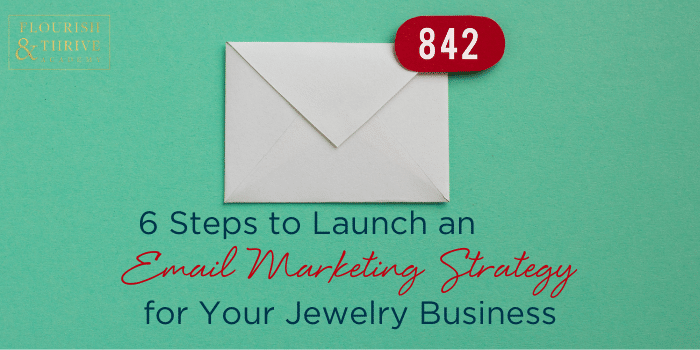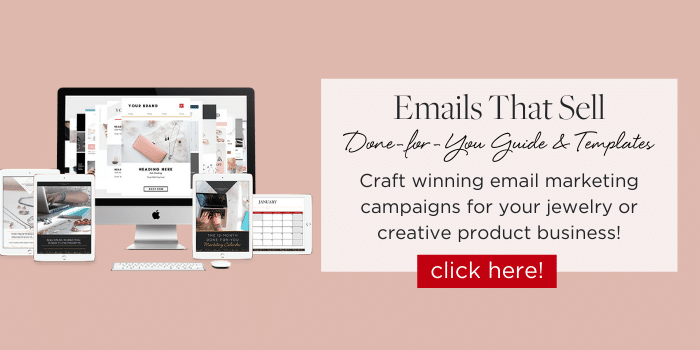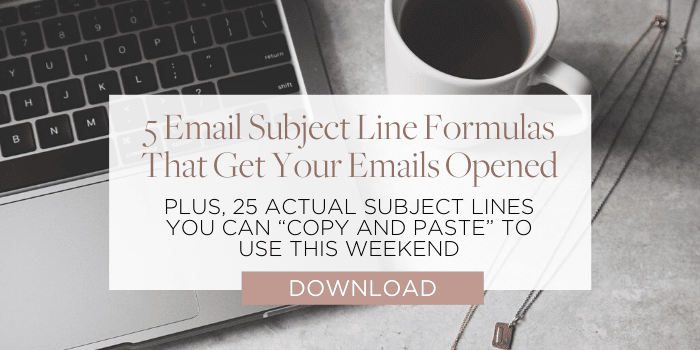6 Steps to Launch an Email Marketing Strategy for your Jewelry Business

It’s no secret that email marketing is a crucial element for marketing a successful creative business. We’re not just saying that! Studies have shown that 59% of marketers say email is their biggest source of ROI.
Maybe you’ve sent out a newsletter or two, or even attempted your own email sales campaign. However, you’re not seeing these incredible sales results that everyone’s been raving about. So what’s missing? One word: strategy.
Like all marketing tactics for your jewelry or creative product business, email marketing requires research, strategy, and consistency to truly make a difference. Good news is, we’ve done the research for you and whipped up 6 simple steps to help you create your very own email marketing strategy.
Email marketing strategies involve a bit of prep work, but don’t worry — the biggest hurdle of launching an email marketing strategy is understanding your audience. Who understands your shoppers better than you?
Let’s get started!
1. Set a Goal
Every email marketing strategy needs to be centered on a goal, otherwise it will be an aimless endeavor.
Take a step back and think about your current store-related problems. If you could pick one problem to address, what would it be? Do you have a new product you want to promote? Are you trying to get rid of some older inventory? Once you have your problem identified, map it to a goal. Here a few common problems and campaign types that remedy them:
- New product to promote: Promoting a new product takes finesse, but it’s also really exciting. This is a new product you’re proud of, after all! If you have a new product to promote, your goal is simple — get your product in front of the right eyes, ASAP.
- Inventory to clear: Ideally you never have old inventory laying around, but it happens to the best of us. If you have inventory you’re tired of looking at, your goal is to again, get your product in front of the right eyes, but with a discount.
- General slump in sales: Times are often tough, in general. In a perfect world you’d be able to sell everything you create, and at full price. But even if you can’t, that’s okay. You can counter a general slump in sales by creating a coupon code and promoting it to your entire base.
You probably notice a trend in the above problem > goal model: every goal is simple and straightforward. Don’t overcomplicate things. Clear your head, go on a walk and think about your problem, and distill it down to as simple a goal as possible.
2. Be Sure of Your Audience
Email marketing for small businesses is all about targeting the right audience. You likely have a good idea of who your audience is already, but it’s never a bad idea to double check.
Look at what you already know and pull from any existing data: insights from previous marketing efforts, general demographic info from your mailing list, or information from your social followers profiles.
3. Create Email List Segments
Once you have your audience pinpointed, it’s time to create the appropriate lists of addresses to send to. These list segments will depend on your audience and goals.
- Promoting a new product: Depending on your jewelry and current list, it’s possible your entire email list is interested in a new product. But, if you’re creating a more niche piece that caters to say, a male audience, you’ll likely want to create a list segment for your male audience.
- Clearing inventory: If you’re running a sale on older jewelry you’re hoping to get rid of, you can likely send an email to everyone. But, don’t rule out creating different segments for men, women, old, young, and so on that use different language in the emails to draw their eye.
- Large sales push: Much like clearing inventory, creating a large sales push via sitewide sale or coupon code can typically be promoted with a mass email send. Think about any kind of sitewide coupon in your inbox right now. It’s probably a templated email the company sent to you and everyone else, with little segmentation going on!
In all of the above scenarios you’ll want to keep in mind that there is merit to segmenting your lists regardless of the goal. For example, some members of your audience likely respond better to a certain type of subject line. This is where A/B testing comes into play. (More on that later.)
4. Build Your Emails
Next, you’ll want to build your emails. If you’re sending a mass email to your entire list, this step is as easy as building one email. Otherwise you’ll want to build a separate email for each list segment.
If you have an email template, use it. This will save you time and still leave room for customization. If you don’t have a template, it’s a good idea to create several branded templates you can quickly customize for various occasions.
When designing your email it’s important to keep your audience and messaging front and center. Use personalization in subject lines where appropriate, and put yourself in your audience’s shoes during the entire process. Ask yourself what kind of subject line, body copy, and images would resonate with them the most.
Once you’ve created your email, do numerous internal test sends to ensure the email displays properly on various browsers and operating systems, as well as iPhone and Android devices.
5. Send A/B Email Tests
Your email is designed and ready to go — you’re almost there. But, don’t hit send quite yet! You need to A/B test your emails and send them out in small batches, trying different subject lines, body copy, and so on.
Choose a set sample size from each list segment and send two types of emails out, each email testing a different subject line or body copy (or both). Wait a few days and see how the email performs with each segment. Then, take note of the data so you can improve your emails before sending out the final version to the rest of your list.
For example, let’s say you notice the email with subject line A sent to a particular segment had a higher open rate than the email sent with subject line B. This tells you the first email subject line likely resonated with your audience more effectively. Or, if you have a high open rate with one type of email but nobody’s clicking the link, you know the body copy or call to action (CTA) likely needs to be adjusted.
Also, it’s worth pointing out just how important it is you store all of this data. Over time you’ll have enough information to help you fine tune every email send and maximize your open rates and click thru rates. To get an idea of whether or not your emails are performing well, be sure to look at industry averages for your niche.
6. Schedule and Send Your Emails
Once you’ve taken note of which emails performed the best and made any appropriate adjustments, it’s time to click that giant send button.
After your emails are sent, sit back and wait. Don’t obsess over open rates and other analytics right away, but keep your eyes open for any bounced emails. An email can bounce for many reasons, but typically this occurs because an email address is incorrect or inactive. If an email bounces, remove that address from your list.
As your emails go out and the data comes in, take note of open and click thru rates, and be sure to pay special attention to emails that perform particularly well. Remember: every success is replicable, while every failure is simply an opportunity for growth.
Get a Head Start with Our Email Bundle
Email’s a cheap, lucrative way to get your beautiful jewelry directly in front of your customers. But, it can feel overwhelming at times. To help you get started on the right foot and take out a lot of the guesswork, we’ve created a bundle of tested subject lines, templates, and more.
Your time is valuable. Focus on creating unique works of art and let us handle the marketing for you.

Secure your copy of our Emails That Sell Done For You Bundle today!

